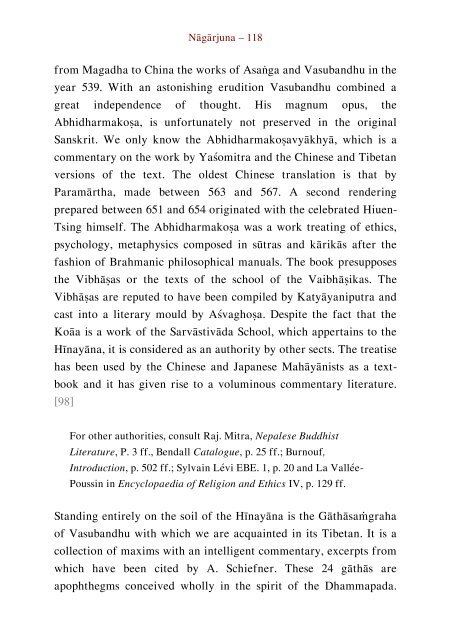Literary History of Sanskrit Buddhism
A study by J. K. Nariman of Sanskrit Buddhism from the Early Buddhist Tradition up to the Mahayana texts proper.
A study by J. K. Nariman of Sanskrit Buddhism from the Early Buddhist Tradition up to the Mahayana texts proper.
You also want an ePaper? Increase the reach of your titles
YUMPU automatically turns print PDFs into web optimized ePapers that Google loves.
Nāgārjuna – 118<br />
from Magadha to China the works <strong>of</strong> Asaṅga and Vasubandhu in the<br />
year 539. With an astonishing erudition Vasubandhu combined a<br />
great independence <strong>of</strong> thought. His magnum opus, the<br />
Abhidharmakoṣa, is unfortunately not preserved in the original<br />
<strong>Sanskrit</strong>. We only know the Abhidharmakoṣavyākhyā, which is a<br />
commentary on the work by Yaśomitra and the Chinese and Tibetan<br />
versions <strong>of</strong> the text. The oldest Chinese translation is that by<br />
Paramārtha, made between 563 and 567. A second rendering<br />
prepared between 651 and 654 originated with the celebrated Hiuen-<br />
Tsing himself. The Abhidharmakoṣa was a work treating <strong>of</strong> ethics,<br />
psychology, metaphysics composed in sūtras and kārikās after the<br />
fashion <strong>of</strong> Brahmanic philosophical manuals. The book presupposes<br />
the Vibhāṣas or the texts <strong>of</strong> the school <strong>of</strong> the Vaibhāṣikas. The<br />
Vibhāṣas are reputed to have been compiled by Katyāyaniputra and<br />
cast into a literary mould by Aśvaghoṣa. Despite the fact that the<br />
Koāa is a work <strong>of</strong> the Sarvāstivāda School, which appertains to the<br />
Hīnayāna, it is considered as an authority by other sects. The treatise<br />
has been used by the Chinese and Japanese Mahāyānists as a textbook<br />
and it has given rise to a voluminous commentary literature.<br />
[98]<br />
For other authorities, consult Raj. Mitra, Nepalese Buddhist<br />
Literature, P. 3 ff., Bendall Catalogue, p. 25 ff.; Burnouf,<br />
Introduction, p. 502 ff.; Sylvain Lévi EBE. 1, p. 20 and La Vallée-<br />
Poussin in Encyclopaedia <strong>of</strong> Religion and Ethics IV, p. 129 ff.<br />
Standing entirely on the soil <strong>of</strong> the Hīnayāna is the Gāthāsaṁgraha<br />
<strong>of</strong> Vasubandhu with which we are acquainted in its Tibetan. It is a<br />
collection <strong>of</strong> maxims with an intelligent commentary, excerpts from<br />
which have been cited by A. Schiefner. These 24 gāthās are<br />
apophthegms conceived wholly in the spirit <strong>of</strong> the Dhammapada.


















